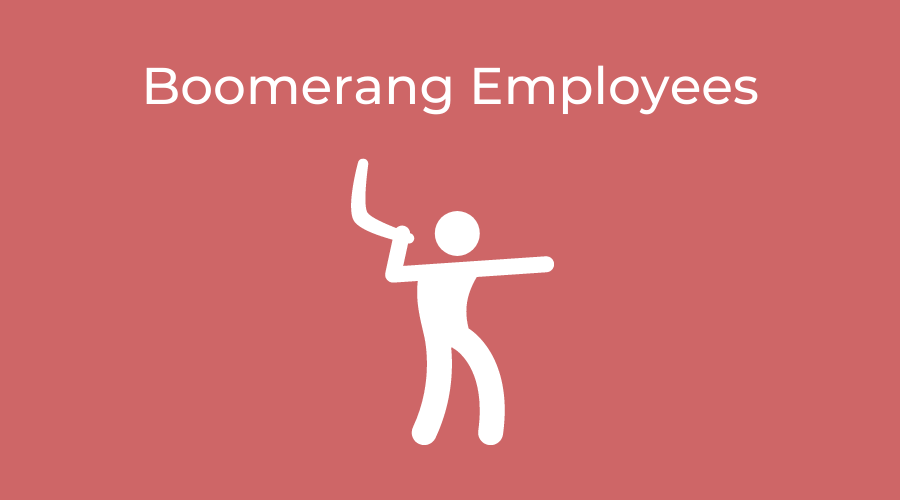
Boomerang Employees
Several years ago, while attending a work function for an employee resource group I was a member of, a speaker mentioned that you must sometimes leave your employer to see a significant pay increase and then come back. While it may seem shocking for some, more and more employers are seeing boomerang employees or returning employees.
Why do employees leave in the first place?
Employees leave for different reasons – whether they’re trying to escape a toxic environment, or a job opportunity was offered to them, and it was too good to ignore – they leave because the grass appears greener on the other side.
The Conference Board reported that 2022 salary increase budgets were estimated to be 3.9%, the highest it’s been since 2008. Historically those budgets are never higher than 3%. Moreover, internal promotions often come with a cap, so it’s extremely difficult to receive a promotion with a significant increase. On the other hand, external hires receive 18-20% more than internal candidates.
While employers do realize it’s cheaper to keep employees, the power is no longer in their hands. Not only is it a candidate’s market, but candidates are also refusing to compromise in certain areas. Where companies are forcing employees to return to the office, candidates are looking for remote first or remote only companies. Entire industries are facing candidate shortages – like the fast-food industry – because of low wages. In response, some employers are adapting to the times by offering remote work or increasing minimum wages. Simply put, the great resignation is opening the doors for boomerang employees.
Should you hire a boomerang employee?
Yes! Boomerang employees are like internal employees, as they’re familiar with the culture of the organization and are proficient in the technology the organization uses. Where onboarding someone completely unfamiliar with the ins and outs of the organization means you must teach them the nuances of the role and organization, you do not have to do this with boomerang employees. Also, if a boomerang employee left because of a lack of upward mobility, between the great resignation and retirement, roles may be more available today than they were previously.
Boomerang employees are also familiar with their coworkers, as they’ve more than likely worked with them before. This eliminates the need to build rapport and ensures that already tight deadlines can be achieved without typical new group development dynamics – forming, storming, norming, and performing. Depending on how long the boomerang employee worked with you before they left, they may be able to address any brain drains that were exacerbated because of them leaving.
What are the downfalls of hiring a boomerang employee?
Businesses suffer great losses when a high potential employee leaves. A high potential may have been in a succession plan and was being groomed to take on future leadership positions or they may have been so invaluable they were doing the work of multiple employees. Backfilling their position was not easy. However, when they return, they bring back their potential with the bonus of having acquired new skills since previously being employed.
But what happens when it isn’t a high potential that’s returning? When a problematic or less than stellar employee returns, their issues may return with them. While you can circumvent this by marking the employee as ineligible for rehire, if the hire’s performance wasn’t addressed when they were originally employed, they could dispute those findings and win.
So how do you ensure the “right” boomerang employee was hired?
To start, look at your current performance management policies and fill any gaps in the process. You cannot fix what was never addressed. You also cannot improve what you fail to acknowledge. Once that’s solidified then review your job descriptions and hiring process to ensure you’re objectively ending with the best candidate for each opening.
Another tactic to create a welcoming environment for boomerang employees is to create a talent community, especially for them. Some companies have done this with retired employees or interested external candidates. To provide a community for potential boomerang employees means you continue to nurture them as passive candidates and then whenever a job opportunity of interest becomes available, they’re more likely to apply.
Lastly, you could continue to nurture potential boomerang employees by connecting with them in professional communities, like LinkedIn, and periodically checking in with them. Either way, in today’s current landscape it’s more and more common to see a boomerang employee or two. Welcome them as you would any external candidate and nurture them like you intend to retain them for the long-term.
Timara Nichols has 15+ years of experience, specializing in human resources, operations, and customer success. She holds the following certifications – aPHR, Certified ScrumMaster, and Meta Certified Community Manager. She’s passionate about talent and people operations.


